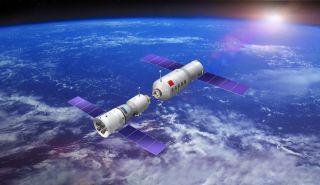
Tiangong-1 is a single-module space station operated by the China National Space Administration. The module was launched in 2011 and hosted two crews of taikonauts (Chinese astronauts) in 2012 and 2013. Since China’s space agency discloses less information about its missions than other space agencies, the details surrounding the space station are not widely known.
The orbit of the space station passes over most of the civilized world, with the exclusion of northern latitudes that include the United States, Russia and Canada, as well as the extreme south of the world, including Antarctica and the tip of South Africa. However, most of the Earth is covered by water, reducing the chances of a crash in a populated area.
Tiangong-1 (whose name means “Heavenly Palace”) weighs about 8.5 metric tons, and is about 34 feet long by 11 feet wide (10.4 meters by 3.4 meters). It contains an experiment module — where the astronauts live and work — and a resource module that contains propellant tanks and rocket engines.
A primary goal for the module was to help the Chinese practice space dockings, which is an important skill for nations looking to build larger space stations or to send multiple spacecraft to the moon, Mars or other locations in the solar system.
Picture Credit : Google

